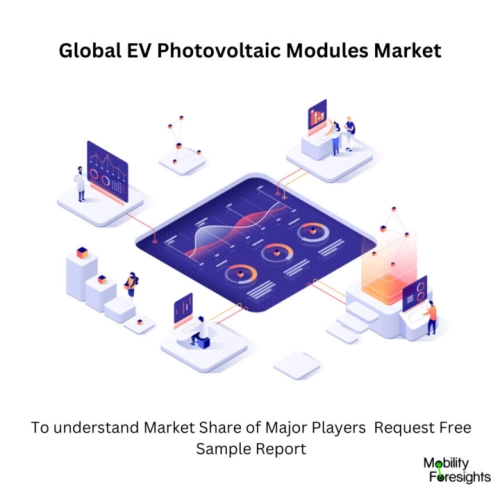
- Get in Touch with Us

Last Updated: Apr 25, 2025 | Study Period: 2024-2030
Solar energy is transformed into electrical energy using photovoltaic (PV) devices, which comprise semiconducting components. The term "cell" refers to a single PV device, whereas "module" or "panel" refers to the bigger units formed when many cells are chained together.
The photovoltaic effect allows photovoltaic modules, which are made up of several solar cells, to produce electricity from the sun's light energy (photons). Thin-film or wafer-based crystalline silicon cells are used in the majority of modules.
Electric vehicles known as solar cars employ photovoltaic (PV) cells to convert sunlight into electrical energy for the vehicle's battery and electric motors. For both general usage and solar car racing, solar automobiles have been developed.

The Global EV photovoltaic modules market accounted for $XX Billion in 2023 and is anticipated to reach $XX Billion by 2030, registering a CAGR of XX% from 2024 to 2030.
Aptera Launch Edition Runs On Sun Power.Aptera Motors, a car manufacturer, seeks to modernise everything about electric vehicles, including the technology.
The first is that it views automobiles as legal spacecraft that can quickly and smoothly enter the streets. Then, solar panels are added to the roofs to ensure that drivers won't need to recharge their automobiles for several months in addition to electrifying the cars.
'Aptera Launch Edition', a solar vehicle, does this. The war wagon-like design of the ultra-lightweight body, which acknowledges the usage of carbon, suggests that it is suited for drifting and street racing.
With its 700 watts of unique solar power, Aptera's solar vehicle Launch, according to the company, can go up to 40 miles per day entirely on solar power and will never need to be plugged in to recharge.
Since any ordinary power outlet may work well for the EV car, Aptera tells drivers they won't need to worry about where to charge their solar vehicle. The 400-mile range, two-seat, three-wheeled solar vehicle propels itself from 0 to 60 mph in four seconds.
Crash testing and validation will be finished by Aptera as part of the fourth and final phase of its product development, known as Delta.
Once finished, Aptera intends to expand up swiftly to a full-scale production of 10,000 vehicles annually in a single shift. Following that, according to Aptera, it will increase output to dual shift 20,000 vehicles annually out of its Carlsbad, California factory.
| Sl no | Topic |
| 1 | Market Segmentation |
| 2 | Scope of the report |
| 3 | Abbreviations |
| 4 | Research Methodology |
| 5 | Executive Summary |
| 6 | Introdauction |
| 7 | Insights from Industry stakeholders |
| 8 | Cost breakdown of Product by sub-components and average profit margin |
| 9 | Disruptive innovation in theIndustry |
| 10 | Technology trends in the Industry |
| 11 | Consumer trends in the industry |
| 12 | Recent Production Milestones |
| 13 | Component Manufacturing in US, EU and China |
| 14 | COVID-19 impact on overall market |
| 15 | COVID-19 impact on Production of components |
| 16 | COVID-19 impact on Point of sale |
| 17 | Market Segmentation, Dynamics and Forecast by Geography, 2024-2030 |
| 18 | Market Segmentation, Dynamics and Forecast by Product Type, 2024-2030 |
| 19 | Market Segmentation, Dynamics and Forecast by Application, 2024-2030 |
| 20 | Market Segmentation, Dynamics and Forecast by End use, 2024-2030 |
| 21 | Product installation rate by OEM, 2023 |
| 22 | Incline/Decline in Average B-2-B selling price in past 5 years |
| 23 | Competition from substitute products |
| 24 | Gross margin and average profitability of suppliers |
| 25 | New product development in past 12 months |
| 26 | M&A in past 12 months |
| 27 | Growth strategy of leading players |
| 28 | Market share of vendors, 2023 |
| 29 | Company Profiles |
| 30 | Unmet needs and opportunity for new suppliers |
| 31 | Conclusion |
| 32 | Appendix |